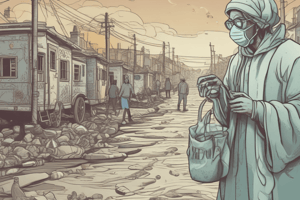Podcast
Questions and Answers
What is the mechanism by which V. cholerae causes acute diarrhea?
What is the mechanism by which V. cholerae causes acute diarrhea?
- Releasing a toxin that binds to lipopolysaccharide receptors on the surface of intestinal epithelium cells
- Releasing a toxin that binds to carbohydrate receptors on the surface of intestinal epithelium cells, causing water influx and shock
- Releasing a toxin that binds to ganglioside receptors on the surface of intestinal epithelium cells, triggering cAMP production and ion channel activation (correct)
- Releasing a toxin that binds to cholesterol receptors on the surface of intestinal epithelium cells, leading to water efflux and dehydration
What effect does the build-up of ions in the intestinal lumen have on the body?
What effect does the build-up of ions in the intestinal lumen have on the body?
- It stimulates cAMP production, leading to ion efflux from the cell
- It causes water influx into the cell, leading to dehydration
- It draws water from cells and tissues via osmosis, causing acute diarrhea (correct)
- It triggers the production of cholera toxin, causing severe dehydration
What is the appearance of diarrhea due to cholera?
What is the appearance of diarrhea due to cholera?
- Clear and odorless
- Thick and brown in color
- Thick and yellow in color
- Milky and pale, resembling water in which rice has been rinsed (correct)
What can severe dehydration due to cholera lead to if left untreated?
What can severe dehydration due to cholera lead to if left untreated?
What is the causal agent for cholera?
What is the causal agent for cholera?
Which mechanism allows pathogens to attach to host cells?
Which mechanism allows pathogens to attach to host cells?
What causes post-streptococcal diseases like rheumatic fever and glomerulonephritis?
What causes post-streptococcal diseases like rheumatic fever and glomerulonephritis?
How do bacteriophages contribute to bacterial virulence?
How do bacteriophages contribute to bacterial virulence?
What is the distinction between intracellular and extracellular pathogens related to?
What is the distinction between intracellular and extracellular pathogens related to?
How do pathogens enter the body?
How do pathogens enter the body?
What can Streptococcus pyogenes cause?
What can Streptococcus pyogenes cause?
What is a sequela of pharyngitis or skin infections?
What is a sequela of pharyngitis or skin infections?
What leads to acquisition of specific virulence attributes in bacteria?
What leads to acquisition of specific virulence attributes in bacteria?
How do bacteriophages contribute to lysogenic conversion?
How do bacteriophages contribute to lysogenic conversion?
What causes damage in post-streptococcal glomerulonephritis?
What causes damage in post-streptococcal glomerulonephritis?
What do antibodies against M protein cross-react with in rheumatic fever?
What do antibodies against M protein cross-react with in rheumatic fever?
Exotoxins are best described as:
Exotoxins are best described as:
Which type of exotoxin lyses host cells by creating protein channels in the plasma membrane?
Which type of exotoxin lyses host cells by creating protein channels in the plasma membrane?
Which of the following is a main cause of septic shock?
Which of the following is a main cause of septic shock?
What is the leading cause of death in intensive care units with a mortality rate of 30-50%?
What is the leading cause of death in intensive care units with a mortality rate of 30-50%?
Which of the following is a characteristic of the biofilm mode of growth?
Which of the following is a characteristic of the biofilm mode of growth?
What is used as a source of iron in bacterial iron acquisition?
What is used as a source of iron in bacterial iron acquisition?
Flashcards are hidden until you start studying
Study Notes
- Exotoxins: proteins released by pathogens into the surroundings as they grow, specifically targeting cells and tissues.
- Endotoxins: structural component of Gram-negative bacterial cell walls (LPS) that can be toxic to specific hosts.
- Injected toxins: toxins directly injected into mammalian cells.
Exotoxins:
- AB exotoxins: composed of two subunits, A subunit responsible for toxic effect and B subunit binding to specific target cells.
- Membrane-disrupting toxins:
- Pore forming toxins: lyse host cells by creating protein channels in the plasma membrane.
- Leukocidins: kill leukocytes (neutrophils, T lymphocytes) and dendritic cells, contributing to innate and adaptive immune responses.
- Hemolysins: lyse red blood cells.
- Phospholipases: hydrolyze phospholipids and destroy local populations of white blood cells and red blood cells.
Endotoxins:
- Main cause of septic shock: characterized by fever, hypotension, and disseminated intravascular coagulation.
- Septic shock is leading cause of death in intensive care units with a mortality rate of 30-50%.
- Gram-negative bacteria produce endotoxins, primarily lipopolysaccharide, which can induce disease.
Injected toxins:
- Neutralized by specific antibodies.
- Potential vaccine candidates.
- Toxins injected into the cytoplasm cannot be neutralized.
- Toxin production and direct injection occur only upon bacteria contact with the target cell.
- Many human pathogens produce eukaryotic cell effectors/toxins.
Biofilm mode of growth:
- Physiologically different from planktonic growth.
- Can cause chronic infections.
- Increases virulence.
- Becomes less sensitive to antibiotics.
- Makes cells in the biofilm more resistant to host defense.
Bacterial iron acquisition:
- Uses siderophores, hemophores, and bacterioferritin.
- Host transferrin and lactoferrin are sources of iron.
- Free iron (Fe3+) is chelated by siderophores and hemophores.
- Iron is transported into the cell by receptors and heme-binding proteins.
- Stored iron (bacterioferritin) is used as an energy source.
Studying That Suits You
Use AI to generate personalized quizzes and flashcards to suit your learning preferences.





